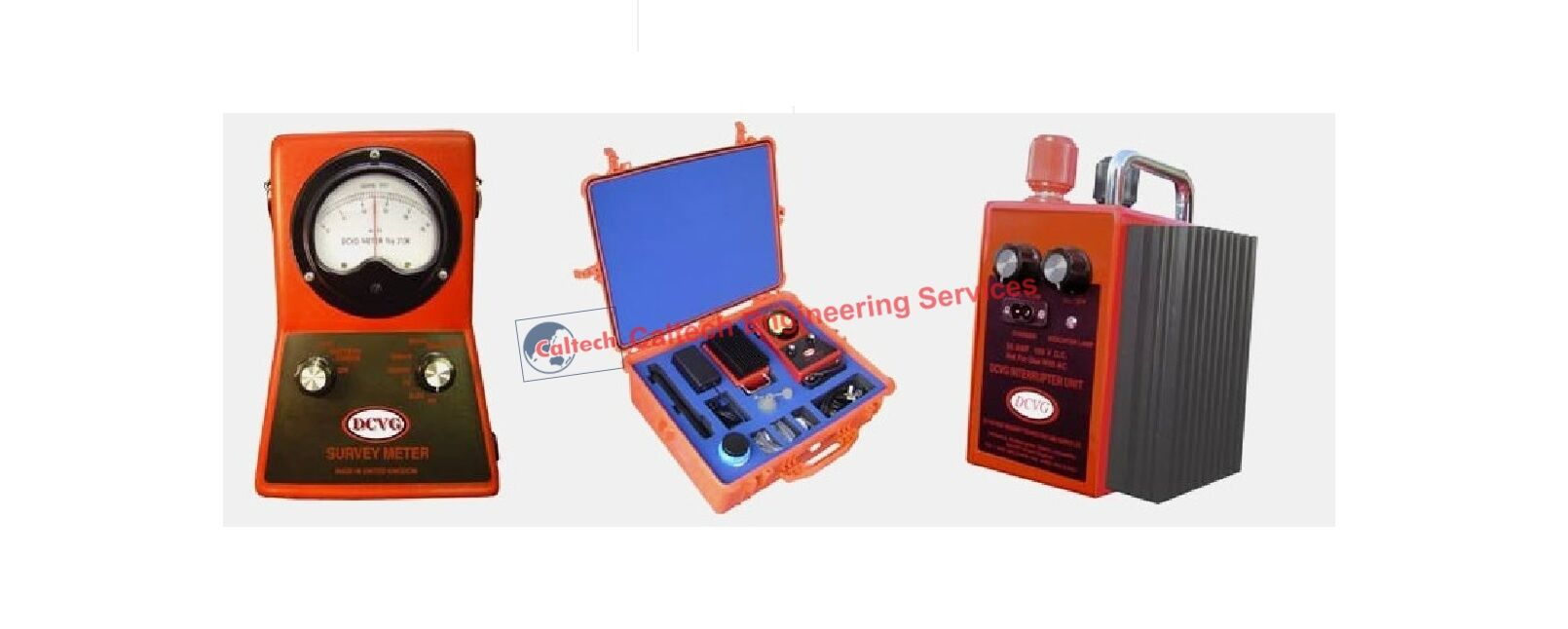Caltech India offers basic and standard DCVG equipment. DCVG-UK manufactured useful equipment. when DC is applied to a pipeline in the same manner as in cathodic protection, a voltage gradient is established in the ground due to the passage of current through the resistive soil to the bare steel exposed at a coating fault.
The voltage gradient becomes larger and more concentrated the greater the current flowing and the closer you are to a coating fault location. In general, the larger the fault, the greater the current flow and hence bigger the voltage gradient.
The direct current voltage gradient method (DCVG) uses a sensitive mili-volt meter, to indicate the potential difference between two copper/copper sulphate half cells placed in the soil in the voltage gradient at ground level. If spaced two metres apart in a voltage gradient, one half cell will adopt a more positive potential than the other, which thus enables the size of the gradient and direction of the current flow causing the voltage gradient to be established.
To make it easier to interpret and to separate what is being monitored from other DC sources such as long line cells, telluric, other CP systems, etc., in the DC Voltage Gradient Technique, the asymmetrical DC signal impressed onto the pipeline is switched ON and OFF at the rate of 0.45 seconds ON, 0.8 seconds OFF. The DC signal can be impressed on top of existing CP systems or the pipeline CP Transformer Rectifiers (T/R) can be switched by using a special interrupter inserted into the negative lead from the Transformer Rectifier.
The DC signal can even be injected at a test post using batteries or a portable DC generator and temporary ground bed.
In carrying out a survey, the surveyor walks the pipeline route testing at regular intervals with the probes in a position of one in front of the other, separated by one to two metres, parallel and preferably above the pipeline, (though not essential provided you can pick up the voltage gradient from faults in the pipeline route). As a fault is approached, the surveyor will see the milli-volt meter start to respond to the ON/OFF pulsed current, which is either a coating fault or interference from another structure. When the fault is passed, the needle deflection completely reverses and slowly decreases as the surveyor moves away from the fault. By retracing, the position of the probes can be found where the needle shows no deflection, ie: a null. The fault is then sited midway between the two copper/copper sulphate half cells.
This procedure is repeated at right angles to the first set of observations and where the two midway positions cross is the epicentre of the voltage gradient. This is directly above the coating fault.
Once located a series of electrical measurements are made that allow the severity of the fault and its corrosion status to be determined.A Full List of All Components That Make Up A STANDARD DCVG Equipment Package
Always specify the type and switching capacity of the required interrupter for your DCVG Set
- 50 Amp Stand Alone.
- 125 Amp Stand Alone.
- 50 Amp Satellite Synchronised
- 125 Amp Satellite Synchronised
- DCVG Satellite Interrupters work with Quantum CIPS equipmentSAFETY NOTE. All our Interrupters are not meant for switching AC as we consider that Surveyors should not be touching any AC wiring in Rectifiers.
DCVG Survey Meter 1
Probe Bias Handles 2
Copper Sulphate Probe Electrodes 2
Right Hand Connection Lead 1
Left Hand Connection Lead 1
Reference Probe Tip Holders 2
Probe Tip Washers 4
Wooden Probe Tips 4
PTFE Sealing Tape 1
120/240 Volt Battery Charger 1
Battery Charger Connection Lead 1
Probe Filler Bottle 1
Copper Sulphate Crystals (JAR) 1
Equipment All weather Carry Case 1
Probe All Weather Carry Case 1
DCVG Instruction Manual 1
In India, we have various customers from Mumbai, Delhi, Bangalore, Chennai, Hyderabad, Ahmedabad, Kolkata, Surat, Pune, Jaipur, Lucknow, Kanpur, Nagpur, Visakhapatnam, Indore, Bhopal, Patna, Vadodara, Ghaziabad, Ludhiana, Coimbatore, Madurai, Nashik, Srinagar, Aurangabad, Dhanbad, Allahabad and Ranchi in India.
